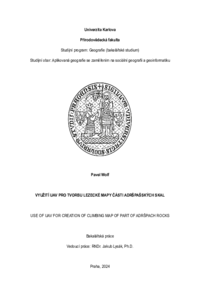Využití UAV pro tvorbu horolezecké mapy části Adršpašských skal
Use of UAV for the production of the Adršpach Rocks climbing map
bachelor thesis (DEFENDED)

View/
Permanent link
http://hdl.handle.net/20.500.11956/193943Identifiers
Study Information System: 255220
Collections
- Kvalifikační práce [21469]
Author
Advisor
Referee
Šrollerů, Alex
Faculty / Institute
Faculty of Science
Discipline
Social Geography and Geoinformatics
Department
Department of Applied Geoinformatics and Cartography
Date of defense
4. 9. 2024
Publisher
Univerzita Karlova, Přírodovědecká fakultaLanguage
Czech
Grade
Very good
Keywords (Czech)
skalní útvary, pískovcová skalní města, GIS, UAVKeywords (English)
rock formations, sandstone landscapes, GIS, UAVPráce se zabývá možnostmi využití UAV při mapování terénu pískovcového skalního města Adršpach pro účely lezeckých průvodců. Součástí práce je bibliografie a zhodnocení lezeckých průvodců, popisujících Adršpach. V rámci práce byla oblast fotogrammetricky nasnímána pomocí UAV a z tohoto měření byl vytvořen digitální model povrchu oblasti. Tento model byl pak srovnáván s převzatým modelem vytvořeným pomocí leteckého laserového skenování (LLS). U obou těchto modelů byla dále zkoumána jejich využitelnost například pro určení relativních výšek skalních věží či jejich souřadnic. Zjištěné souřadnice byly srovnány se souřadnicemi těchto věží v lezeckých databázích. Poslední kapitola praktické části práce se zabývá vizualizací digitálního modelu reliéfu (DMR) tohoto území v prostředí ArcGIS Pro. Klíčová slova: skalní útvary, pískovcová skalní města, GIS, UAV
This work deals with the possibilities of using UAVs in mapping the terrain of the sandstone rock city of Adršpach for the purpose of climbing guides. The thesis includes a bibliography and evaluation of climbing guides describing Adršpach. As part of the work, the area was photogrammetrically imaged using a UAV and from this measurement a digital surface model of the area was created. This model was then compared with the adopted model created by airborne laser scanning (ALS). Both of these models were examined in terms of their usefulness for determining e.g. the relative heights of rock towers or their coordinates. The found coordinates were then compared with the coordinates of these towers in climbing databases. The last chapter of the practical part deals with the visualization of the digital elevation model (DEM) of the area in ArcGIS Pro. Key words: rock formations, sandstone landscapes, GIS, UAV
